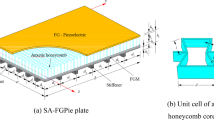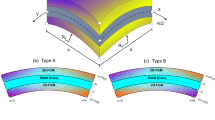Abstract
The complementary functions method (CFM) is used to investigate the static behavior of laminated composite frames consisting of straight and/or curved members of variable cross section. The Timoshenko beam theory (TBT) is used to obtain the set of the governing equations. The fifth-order Runge–Kutta (RK5) algorithm is employed in the solution process of initial value problems via the CFM. A computer program is substantially coded in Fortran on rigidity matrix based on the CFM to acquire the rigidity matrices and load vectors of these structural elements. With the help of the suggested method, the influences of the symmetric layer stacking sequence, the ratio of E1/E2, and various boundary conditions on the nodal displacements and element end forces of the considered frames are investigated. Carrying out the static behavior of laminated composite frame systems which contain straight and circular axis elements for the first time by using the CFM is the novelty of this study. Verification and accuracy of the suggested scheme are intently performed through the comparison of the present results with those of the finite element method. The effectiveness of the method and good agreement of the results are observed.












Similar content being viewed by others
Data availability statement
Some or all data, models or code generated or used during the study are available from the corresponding author by request.
References
Vo TP, Thai HT (2012) Static behavior of composite beams using various refined shear deformation theories. Compos Struct 94(8):2513–2522
Ditaranto RA (1973) Static analysis of a laminated beam. J Eng Ind Trans ASME 95:755–761
Reddy JN, Wang CM, Lee KH (1997) Relationships between bending solutions of classical and shear deformation beam theories. Int J Solids Struct 34(26):3373–3384
Karamanlı A (2017) Bending analysis of composite and sandwich beams using Ritz method. Anadolu Univ J Sci Technol A Appl Sci Eng 19(1):10–23
Catapano A, Giunta G, Belouettar S, Carrera E (2011) Static analysis of laminated beams via a unified formulation. Compos struct 94(1):75–83
Özütok A, Madenci E (2017) Static analysis of laminated composite beams based on higher-order shear deformation theory by using mixed-type finite element method. Int J Mech Sci 130:234–243
Pagani A, Yan Y, Carrera E (2017) Exact solutions for static analysis of laminated, box and sandwich beams by refined layer-wise theory. Compos Part B Eng 131:62–75
Ecsedi I, Baksa A (2011) Static analysis of composite beams with weak shear connection. Appl Math Model 35(4):1739–1750
Aguiar RM, Moleiro F, Soares CM (2012) Assessment of mixed and displacement-based models for static analysis of composite beams of different cross-sections. Compos Struct 94(2):601–616
Eisenberger M (2003) An exact high order beam element. Comput Struct 81(3):147–152
Khdeir AA, Reddy JN (1997) An exact solution for the bending of thin and thick cross-ply laminated beams. Compos Struct 37(2):195–203
Yuan FG, Miller RE (1990) A higher order finite element for laminated beams. Compos Struct 14(2):125–150
Yu H (1994) A higher-order finite element for analysis of composite laminated structures. Compos Struct 28(4):375–383
Vo TP, Thai HT, Nguyen TK, Lanc D, Karamanli A (2017) Flexural analysis of laminated composite and sandwich beams using a four-unknown shear and normal deformation theory. Compos Struct 176:388–397
Cunedioğlu Y (2017) Statics and buckling analysis of aluminum beams with composite coats. Omer Halisdemir Univ J Eng Sci 6(2):729–736
Masjedi PK, Weaver PM (2020) Analytical solution for the fully coupled static response of variable stiffness composite beams. Appl Math Model 81:16–36
Daví G, Milazzo A, Orlando C (2014) An analytical solution for multilayered beams subjected to ends loads. Compos Struct 116:772–781
Vukasović M, Pavazza R, Vlak F (2017) An analytic solution for bending of thin-walled laminated composite beams of symmetrical open sections with influence of shear. J Strain Anal Eng Des 52(3):190–203
Saraçoğlu M, Güçlü G, Fethullah USLU (2019) Static analysis of orthotropic Euler–Bernoulli and Timoshenko beams with respect to various parameters. Bitlis Eren Univ J Sci 8(2):628–641
Elshafei MA (2013) FE Modeling and analysis of isotropic and orthotropic beams using first order shear deformation theory. Mater Sci Appl 4:77–102
Zghal S, Ataoui D, Dammak F (2020) Static bending analysis of beams made of functionally graded porous materials. Mech Based Des Struct Mach. https://doi.org/10.1080/15397734.2020.1748053
Doeva O, Khaneh Masjedi P, Weaver PM (2020) Exact solution for the deflection of composite beams under non-uniformly distributed loads. In: AIAA Scitech 2020 Forum, p 0245
Noori AR, Aslan TA, Temel B (2020) Static analysis of FG beams via complementary functions method. Eur Mech Sci 4(1):1–6
Mathiyazhagan G, Vasiraja N (2013) Finite element analysis on curved beams of various sections. In: 2013 International conference on energy efficient technologies for sustainability. IEEE, pp 168–173
Barhate BR, Waghe UP (2016) Static analysis of composite laminated beam by first order shear deformation theory. Int J Eng Appl Sci 3(11):257559
Alaimo A, Davì G, Milazzo A, Orlando C (2017) Analytical solution for composite layered beam subjected to uniformly distributed load. Mech Adv Mater Struct 24(16):1315–1324
Sayyad AS, Ghugal YM, Naik NS (2015) Bending analysis of laminated composite and sandwich beams according to refined trigonometric beam theory. Curved Layered Struct. https://doi.org/10.1515/cls-2015-001
Pandey N, Gadade AM (2019) Static response of laminated composite beam subjected to transverse loading. Mater Today Proc 16:956–963
Ghugal ASY (2011) Effect of transverse shear and transverse normal strain on bending analysis of cross-ply laminated beams. Int J Appl Math Mech 7(12):85–118
Rasooli H, Temel B (2019) Static analysis of frames consisting straight and circular axis beams with a variable cross-section made of laminated composite materials by the complementary functions method. Omer Halisdemir Univ J Eng Sci 8(3):046–056 ((in Turkish))
Ghugal YM, Shinde SB (2013) Flexural analysis of cross-ply laminated beams using layerwise trigonometric shear deformation theory. Latin Am J Solids Struct 10(4):675–705
Aslan TA, Noori AR, Temel B (2017) Static analysis of the circular structural elements with the complementary functions method. Çukurova Univ J Fac Eng Archit 32(1):23–29 ((in Turkish))
Karacam F, Timarci T (2005) Bending of cross-ply beams with different boundary conditions. In: International scientific conference, 24–25 November 2005, GABROVO
Madenci E, Özkılıç YO, Gemi L (2020) Experimental and theoretical investigation on flexure performance of pultruded GFRP composite beams with damage analyses. Compos Struct 242:112162
Madenci E, Özütok A (2017) Variational approximate and mixed-finite element solution for static analysis of laminated composite plates. Solid State Phenom 267:35–39
Madenci E, Özütok A (2020) Variational approximate for high order bending analysis of laminated composite plates. Struct Eng Mech 73(1):97–108
Temel B, Noori AR (2019) Out-of-plane vibrations of shear-deformable AFG cycloidal beams with variable cross section. Appl Acoust 155:84–96
Çalım FF (2003) Dynamic analysis of viscoelastic, anisotropic curved spatial rod systems. PhD. Thesis, University of Cukurova, Adana, (In Turkish)
Noori AR, Aslan TA, Temel B (2021) dynamic analysis of functionally graded porous beams using complementary functions method in the Laplace domain. Compos Struct 256:113094
Yildirim S (2020) Hydrogen elasticity solution of functionally-graded spheres, cylinders and disks. Int J Hydrog Energy 45(41):22094–22101
Yildirim S (2020) Free vibration analysis of sandwich beams with functionally-graded cores by complementary functions method. AIAA J 12:1–9
Temel B, Aslan TA, Noori AR (2017) An efficient dynamic analysis of planar arches. Eur Mech Sci 1(3):82–88
Noori AR, Temel B (2020) On the vibration analysis of laminated composite parabolic arches with variable cross-section of various ply stacking sequences. Mech Adv Mater Struct 27(19):1658–1672
Jamil H, Tutuncu N (2019) Numerical methods in calculating eigenvalues: case studies in stability of Euler columns. ALKU J Sci 1(3):156–164
ANSYS, Inc Release 15.0, Canonsburg, PA 2013
Rasooli H (2020) Static analysis of composite circular and straight axis beam systems by the complementary functions method (published). MSC Thesis, Cukurova University, Adana, Turkey
Mechanical APDL element reference. Inc., 275 Technology Drive, Canonsburg, PA15317, 2013
Mechanical APDL theory reference. Inc., 275 Technology Drive, Canonsburg, PA15317, 2013
Hull D, Clyne TW (1996) An introduction to composite materials. Cambridge solid state science series
Jones RM (1999) Mechanics of COMPOSITE MATERIALS. Taylor & Francis. Inc., USA
Author information
Authors and Affiliations
Corresponding author
Ethics declarations
Conflict of interest
The authors declare that they have no conflict of interest.
Additional information
Technical Editor: Aurelio Araujo.
Publisher's Note
Springer Nature remains neutral with regard to jurisdictional claims in published maps and institutional affiliations.
Appendix A: Formulations for composite materials
Appendix A: Formulations for composite materials
The stress–strain and strain–stress relations for composite materials in 1, 2, 3 coordinate systems are written, respectively, as:
In the above relations the notation \(C^{\prime}_{ij}\) and \(S^{\prime}_{ij}\) shows the transformed stiffness and compliance matrices and can be calculated as follows [38, 43].
The transformation matrices components are defined as
in which \(m = \cos \left( \theta \right)\) and \(n = \sin \left( \theta \right)\).

A, B, F and D matrices are \(\left( {3 \times 3} \right)\) in dimensions and are dependent to the material properties and geometry of the cross section and can be written as follows (see [43] and [50]):
In the above equations \(\varepsilon_{ijk}\) is the permutation tensor and \(\tilde{Q}_{ij}\) is reduced stiffness matrix [43].
The transformed stress–strain relations can be written as
in which the \(\tilde{Q}^{^{\prime}}_{ij}\) show the reduced and transformed stiffness matrix. The nonzero elements of \(\tilde{Q}^{^{\prime}}_{ij}\) are obtained in terms of the general three-dimensional transformed stiffness and compliance matrices.
The transformed stiffness and compliance matrices for an orthotropic material are obtained in the following form.
The nonzero components of the transformed stiffness matrix are obtained as follows
The nonzero components of the compliance matrix are obtained in the following form.
\({\varvec{B}} = {\varvec{F}} = 0\) relation is valid for symmetric laminates.
The nonzero elements of A and D matrices are given in the following equations.
The nonzero elements of the transformed \({\varvec{A}}^{\prime}\) and \({\varvec{D}}^{\prime}\) matrices are calculated by using the following equations.
Rights and permissions
About this article
Cite this article
Rasooli, H., Noori, A.R. & Temel, B. On the static analysis of laminated composite frames having variable cross section. J Braz. Soc. Mech. Sci. Eng. 43, 258 (2021). https://doi.org/10.1007/s40430-021-02973-y
Received:
Accepted:
Published:
DOI: https://doi.org/10.1007/s40430-021-02973-y




